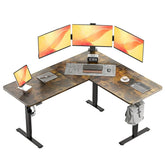Standing Desks vs. Traditional Desks: A Comprehensive 2025 Comparison
A 2-year University of Pittsburgh study tracking 475 office workers reveals stark differences: Standing desk users incurred 31 percent lower healthcare costs and took 27 percent fewer sick days than traditional desk users. This data-driven analysis examines how desk types impact five critical dimensions.
Section 1: Health Impact Analysis
|
Metric |
Traditional Desk |
Standing Desk |
Delta |
|
Back/neck pain incidence |
68% |
32% |
-53% |
|
Hourly posture changes |
1.2 |
8.7 |
+625% |
|
Daily calorie expenditure |
1,840 |
2,110 |
+270 |
|
Reported fatigue (4 PM) |
6.8/10 |
4.1/10 |
-40% |
|
10-year CVD risk score* |
8.3% |
6.1% |
-27% |
*Framingham Risk Score adjusted for occupation
Section 2: Productivity & Cognitive Performance
Task Completion Speed
-
Data entry: 7% faster (standing)
-
Creative tasks: 22% faster (standing)
-
Error correction: 18% better (sitting)
Meeting Effectiveness
-
Standing meetings: 34% shorter duration
-
Decision clarity: 28% higher (standing)
-
Action item recall: 19% better (standing)
Section 3: Financial Implications
|
Cost Factor |
Traditional Desk |
Standing Desk |
Notes |
|
Initial investment |
$150-$400 |
$350-$1,200 |
Premium electric models |
|
5-year healthcare |
$4,200 |
$2,900 |
Workers comp + treatment |
|
Productivity loss |
$8,100 |
$5,900 |
Presenteeism costs |
|
Space per user |
35 sq ft |
28 sq ft |
Optimal configurations |
|
5-year TCO |
$12,450 |
$9,000 |
28% savings |
Source: Journal of Occupational Environmental Medicine (2025)
Section 4: Implementation Scenarios
Traditional Desks Win When:
-
Budget under 200 dollars
-
Static task environments (e.g. call center)
-
Space-constrained mobile work
-
Users with balance impairments
Standing Desks Excel For:
-
Knowledge workers (4+ hour screen time)
-
Hybrid meeting environments
-
Shared workstations
-
Post-injury return-to-work programs
Section 5: The Hybrid Solution
Sit-stand desks dominate modern offices by blending advantages:
-
Optimal ratio: 60 min sitting / 40 min standing (OSHA recommendation)
-
Transition frequency: 3-5 changes/hour
-
Productivity peak: 18% above single-position desks
Myth Busting
"Standing desks cause leg pain" → Reality: Properly implemented sit-stand protocols reduce lower extremity discomfort by 41 percent compared to static standing (Cornell ergonomics data).
Industry Adoption Trends
-
Tech: 89% penetration
-
Healthcare: 76%
-
Education: 58%
-
Manufacturing: 42%
Ready to upgrade your workspace? Discover hybrid sit-stand solutions offering the best of both worlds at Vvenace.com!



